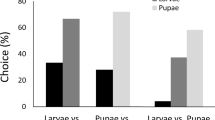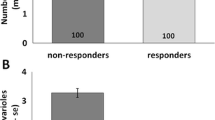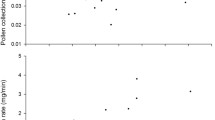Abstract
Despite a presumed fitness advantage for individuals with well-developed cognitive abilities, learning performance is usually found to be highly variable within a population. Although little is currently known about the mechanisms responsible for maintaining such variation, there is correlative evidence to suggest that learning performance may be linked to reproductive physiology in the social insects. Bumble bee colonies naturally undergo an initial co-operative phase, when only the queen reproduces, and a subsequent competition phase when all colony members compete to produce male offspring. We experimentally induced these distinct phases by manipulating the presence/absence of the queen and assessed changes in sucrose responsiveness and learning performance. We found that nest-based workers upregulated their reproductive potential in queenless colonies, and correspondingly, these bees were more responsive to sucrose than their queenright counterparts, performing better in an olfactory learning task as a result. These findings suggest that differences in ovarian development are responsible for at least some of the remarkable variation in learning performance that can be observed among very closely related members of social insect colonies.
Significance statement
Cognitive abilities are often assumed to be inherently adaptive, so the question of why individuals vary in their learning ability has received relatively little attention. Here, we focus on reproductive status as a proximate cause of variation in learning ability in the social insects. We show that a significant proportion of the surprising variation that exists between genetically similar colony members can be explained by worker ovarian development; reproductively active workers are more sensitive to food rewards and thus learn more quickly. Learning ability may be one of a suite of correlated traits that are linked to reproductive physiology in social insects and therefore play an important role in the evolution of division of labour.


Similar content being viewed by others
References
Amdam GV, Norberg K, Fondrk MK, Page RE (2004) Reproductive ground plan may mediate colony-level selection effects on individual foraging behavior in honey bees. Proc Natl Acad Sci U S A 101:11350–11355. doi:10.1073/pnas.0403073101
Amdam GV, Csondes A, Fondrk MK, Page RE (2006) Complex social behaviour derived from maternal reproductive traits. Nature 439:76–78. doi:10.1038/nature04340
Amsalem E, Hefetz A (2010) The appeasement effect of sterility signaling in dominance contests among Bombus terrestris workers. Behav Ecol Sociobol 64:1685–1694. doi:10.1007/s00265-010-0982-4
Amsalem E, Twele R, Francke W, Hefetz A (2009) Reproductive competition in the bumble bee Bombus terrestris: do workers advertise sterility? Proc R Soc Lond B 276:1295–1304. doi:10.1098/rspb.2008.1688
Amsalem E, Shamia D, Hefetz A (2013) Aggression or ovarian development as determinants of reproductive dominance in Bombus terrestris: interpretation using a simulation model. Insect Soc 60:213–222. doi:10.1007/s00040-013-0285-7
Amsalem E, Malka O, Grozinger C, Hefetz A (2014) Exploring the role of juvenile hormone and vitellogenin in reproduction and social behavior in bumble bees. BMC Evol Biol 14:45. doi:10.1186/1471-2148-14-45
Bartoń K (2016) MuMIn: Multi-Model Inference. R package version 1.15.6. Retrieved from http://CRAN.R-project.org/package=MuMIn
Bates D, Maechler M, Bolker B, Walker S (2014) lme4: Linear mixed-effects models using Eigen and s4. R package version 1.1–6: http://CRAN.R-project.org/package=lme4.
Bitterman ME, Menzel R, Fietz A, Schafer S (1983) Classical conditioning of proboscis extension in honeybees (Apis mellifera. J Comp 97:107–119
Bloch G, Hefetz A, Hartfelder K (2000) Ecdysteroid titer, ovary status, and dominance in adult worker and queen bumble bees (Bombus terrestris. J Insect Physiol 46:1033–1040. doi:10.1016/S0022-1910(99)00214-0
Bourke AFG, Ratnieks FLW (2001) Kin-selected conflict in the bumble-bee Bombus terrestris (Hymenoptera: Apidae). Proc R Soc Lond B 268:347–355. doi:10.1098/rspb.2000.1381
Cameron SA (1989) Temporal patterns of division of labor among workers in the primitively eusocial bumble bee, Bombus griseocollis (Hymenoptera: Apidae). Ethology 80:137–151. doi:10.1111/j.1439-0310.1989.tb00735.x
Cameron SA, Robinson GE (1990) Juvenile hormone does not affect division of labor in bumble bee colonies (Hymenoptera: Apidae). Ann Entomol Soc Am 83:626–631. doi:10.1093/aesa/83.3.626
Drezner-Levy T, Smith BH, Shafir S (2009) The effect of foraging specialization on various learning tasks in the honey bee (Apis mellifera). Behav Ecol Sociobol 64:135–148. doi:10.1007/s00265-009-0829-z
Duchateau MJ, Velthuis HHW (1988) Development and reproductive strategies in Bombus colonies. Behaviour 107:186–207
Erber J, Hoormann J, Scheiner R (2006) Phototactic behaviour correlates with gustatory responsiveness in honey bees (Apis mellifera L.). Behav Brain Res 174:174–180. doi:10.1016/j.bbr.2006.07.023
Evans LJ, Raine NE (2014a) Changes in learning and foraging behaviour within developing bumble bee (Bombus terrestris) colonies. PLoS One 9:e90556. doi:10.1371/journal.pone.0090556
Evans LJ, Raine NE (2014b) Foraging errors play a role in resource exploration by bumble bees (Bombus terrestris). J Comp Physiol A 200:475–484. doi:10.1007/s00359-014-0905-3
Foster RL, Brunskill A, Verdirame D, O'Donnell S (2004) Reproductive physiology, dominance interactions, and division of labour among bumble bee workers. Physiol Ento 29:327–334. doi:10.1111/j.0307-6962.2004.00388.x
Geva S, Hartfelder K, Bloch G (2005) Reproductive division of labor, dominance, and ecdysteroid levels in hemolymph and ovary of the bumble bee Bombus terrestris. J Insect Physiol 51:811–823. doi:10.1016/j.jinsphys.2005.03.009
Jandt JM, Dornhaus A (2011) Competition and cooperation: bumblebee spatial organization and division of labor may affect worker reproduction late in life. Behav Ecol Sociobiol 65:2341–2349. doi:10.1007/s00265-011-1244-9
Jandt JM, Bengston S, Pinter-Wollman N, Pruitt J, Raine NE, Dornhaus A, Sih A (2014) Behavioral syndromes and social insects: personality at multiple levels. Biol Rev 89:48–67. doi:10.1111/brv.12042
Jeanson R, Weidenmüller A (2014) Interindividual variability in social insects—proximate causes and ultimate consequences. Biol Rev 89:671–687. doi:10.1111/brv.12074
Latshaw JS, Smith BH (2005) Heritable variation in learning performance affects foraging preferences in the honey bee (Apis mellifera. Behav Ecol Sociobiol 58:200–207. doi:10.1007/s00265-004-0904-4
Lin HR, Winston ML, Haunerland NH, Slessor KN (1999) Influence of age and population size on ovarian development, and of trophallaxis on ovarian development and vitellogenin titres of queenless worker honey bee (Hymenoptera: Apidae). Can Entomol 13:695–706. doi:10.4039/Ent131695-5
Linksvayer TA, Rueppell O, Siegel A, Kaftanoglu O, Page RE Jr, Amdam GV (2009) The genetic basis of transgressive ovary size in honeybee workers. Genetics 183:693–707. doi:10.1534/genetics.109.105452
Muller H, Chittka L (2012) Consistent interindividual differences in discrimination performance by bumblebees in colour, shape and odour learning tasks (Hymenoptera: Apidae: Bombus terrestris). Entomol Gen 34:1–8. doi:10.1127/entom.gen/34/2012/1
Nelson CM, Ihle KE, Fondrk MK, Page RE Jr, Amdam GV (2007) The gene vitellogenin has multiple coordinating effects on social organization. PLoS Biol 5:e62. doi:10.1371/journal.pbio.0050062
Page RE Jr, Amdam GV (2007) The making of a social insect: developmental architectures of social design. Biossays 29:334–343. doi:10.1002/bies.20549
Pankiw T, Page RE Jr (1999) The effect of genotype, age, sex, and caste on response thresholds to sucrose and foraging behavior of honey bees (Apis mellifera L.). J Comp Physiol A 185:207–213. doi:10.1007/s003590050379
Pankiw T, Page RE, Fondrk MK (1998) Brood pheromone stimulates pollen foraging in honey bees (Apis mellifera). Behav Ecol Sociobiol 44:193–198. doi:10.1007/s002650050531
Pankiw T, Waddington KD, Page RE (2001) Modulation of sucrose response thresholds in honey bees (Apis mellifera L.): influence of genotype, feeding, and foraging experience. J Comp Physiol A 187:293–301. doi:10.1007/s003590100201
Perez M, Rolland U, Giurfa M, d'Ettorre P (2013) Sucrose responsiveness, learning success, and task specialization in ants. Learn Memory 20:417–420. doi:10.1101/lm.031427.113
Pinto LZ, Bitondi MMG, Simoes ZLP (2000) Inhibition of vitellogenin synthesis in Apis mellifera workers by a juvenile hormone analogue, pyriproxyfen. J Insect Physiol 46:153–160. doi:10.1016/S0022-1910(99)00111-0
R Core Development Team (2014) R: a language and environment for statistical computing. R Foundation for Statistical Computing, Vienna URL http://www.R-project.org
Raine NE, Chittka L (2008) The correlation of learning speed and natural foraging success in bumble-bees. Proc R Soc Lond B 275:803–808. doi:10.1098/rspb.2007.1652
Raine NE, Chittka L (2012) No trade-off between learning speed and associative flexibility in bumblebees: a reversal learning test with multiple colonies. PLoS One 7:e45096. doi:10.1371/journal.pone.0045096
Raine NE, Ings TC, Ramos-Rodriguez O, Chittka L (2006a) Intercolony variation in learning performance of a wild British bumblebee population (Hymenoptera: Apidae: Bombus terrestris audax). Entomol Gen 28:241–256. doi:10.1127/entom.gen/28/2006/241
Raine NE, Ings TC, Dornhaus A, Saleh N, Chittka L (2006b) Adaptation, genetic drift, pleiotropy, and history in the evolution of bee foraging behavior. Adv Stud Behav 36:305–354. doi:10.1016/S0065-3454(06)36007-X
Riveros AJ, Gronenberg W (2009) Olfactory learning and memory in the bumblebee Bombus occidentalis. Naturwissenschaften 96:851–856. doi:10.1007/s00114-009-0532-y
Rӧseler PF (1974) Comparative studies of oogenesis in bumblebee workers (B. terrestris L) in queenright and queenless colonies. Insect Soc 21:249–274
Röseler P (1977) Juvenile hormone control of oögenesis in bumblebee workers, Bombus terrestris. J Insect Physiol 23:985–992. doi:10.1016/0022-1910(77)90126-3
Scheiner R (2004) Responsiveness to sucrose and habituation of the proboscis extension response in honey bees. J Comp Physiol A 190:727–733. doi:10.1007/s00359-004-0531-6
Scheiner R, Erber J, Page RE Jr (1999) Tactile learning and the individual evaluation of the reward in honey bees (Apis mellifera L.). J Comp Physiol A 185:1–10. doi:10.1007/s003590050360
Scheiner R, Page RE, Erber J (2001a) The effects of genotype, foraging role, and sucrose responsiveness on the tactile learning performance of honey bees (Apis mellifera L.). Neurobiol Learn Mem 76:138–150. doi:10.1006/nlme.2000.3996
Scheiner R, Page RE Jr, Erber J (2001b) Responsiveness to sucrose affects tactile and olfactory learning in preforaging honey bees of two genetic strains. Behav Brain Res 120:67–73. doi:10.1016/S0166-4328(00)00359-4
Scheiner R, Barnert M, Erber J (2003) Variation in water and sucrose responsiveness during the foraging season affects proboscis extension learning in honey bees. Apidologie 34:67–72. doi:10.1051/apido:2002050
Schultz DJ, Pankiw T, Fondrk MK, Robinson GE, Page RE Jr (2004) Comparisons of juvenile hormone hemolymph and octopamine brain titers in honey bees (Hymenoptera: Apidae) selected for high and low pollen hoarding. Ann Entomol Soc Am 97:1313–1319
Smith KE, Raine NE (2014) A comparison of visual and olfactory learning performance in the bumblebee Bombus terrestris. Behav Ecol Sociobiol 68:1549–1559. doi:10.1007/s00265-014-1765-0
Sommerlandt FMJ, Roessler W, Spaethe J (2014) Elemental and non-elemental olfactory learning using PER conditioning in the bumblebee, Bombus terrestris. Apidologie 45:106–115. doi:10.1007/s13592-013-0227-4
Spaethe J, Brockmann A, Halbig C, Tautz J (2007) Size determines antennal sensitivity and behavioral threshold to odors in bumblebee workers. Naturwissenschaften 94:733–739. doi:10.1007/s00114-007-0251-1
Trynor KS, Conte YL, Page RE (2014) Queen and young larvae pheromones impact nursing and reproductive physiology of honey bee (Apis mellifera) workers. Behav Ecol Sociobiol 68:2059–2073. doi:10.1007/s00265-014-1811-y
Tsuruda JM, Page RE Jr (2009) The effects of foraging role and genotype on light and sucrose responsiveness in honey bees (Apis mellifera L.). Behav Brain Res 205:132–137. doi:10.1016/j.bbr.2009.07.022
Van der Blom J, Verkade AJ (1991) Does kin recognition in honey bees Apis mellifera L. influence the workers' chances of becoming egg layers? Anim Behav 42:867–870. doi:10.1016/S0003-3472(05)80136-8
Van Doorn A, Heringa J (1986) The ontogeny of a dominance hierarchy in colonies of the bumblebee Bombus terrestris Hymenoptera Apidae. Insect Soc 33:3–25. doi:10.1007/BF02224031
Van Honk C, Hogeweg P (1981) The ontogeny of the social structure in a captive Bombus terrestris colony. Behav Ecol Sociobiol 9:111–119. doi:10.1007/BF00293582
Visscher PK, Dukas R (1995) Honey bees recognize development of nestmates ovaries. Anim Behav 49:542–544. doi:10.1006/anbe.1995.0074
Wang Y, Kaftanoglu O, Siegel AJ, Page RE Jr, Amdam GV (2010) Surgically increased ovarian mass in the honey bee confirms link between reproductive physiology and worker behavior. J Insect Physiol 56:1816–1824. doi:10.1016/j.jinsphys.2010.07.013
West-Eberhard MJ (1996) Wasp societies as microcosms for the study of development and evolution. Oxford University Press, Oxford
Williams JB, Roberts SP, Elekonich MM (2008) Age and natural metabolically-intensive behavior affect oxidative stress and antioxidant mechanisms. Exp Gerontol 43:538–549. doi:10.1016/j.exger.2008.02.001
Worden BD, Skemp AK, Papaj DR (2005) Learning in two contexts: the effects of interference and body size in bumblebees. J Exp Biol 208:2045–2053. doi:10.1242/jeb.01582
Author information
Authors and Affiliations
Corresponding author
Ethics declarations
Author contributions
EL and LJE conceived the project. LJE, EL and NER designed the research experiments. LJE carried out the experiments. LJE and EL performed the statistical analyses. LJE, EL and NER wrote the manuscript.
Additional information
Communicated by R. F. A. Moritz
Electronic supplementary material
ESM 1
(DOCX 30 kb)
Rights and permissions
About this article
Cite this article
Evans, L.J., Raine, N.E. & Leadbeater, E. Reproductive environment affects learning performance in bumble bees. Behav Ecol Sociobiol 70, 2053–2060 (2016). https://doi.org/10.1007/s00265-016-2209-9
Received:
Revised:
Accepted:
Published:
Issue Date:
DOI: https://doi.org/10.1007/s00265-016-2209-9




